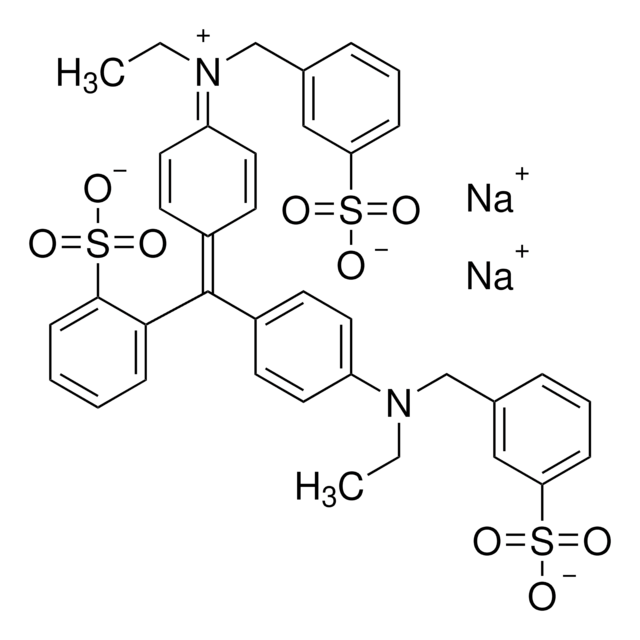Wszystkie zdjęcia(1)
Kluczowe dokumenty
81240
Poly(ethylene glycol)
average Mn 4,000, platelets
Synonim(y):
Polyethylene glycol, PEG
Zaloguj sięWyświetlanie cen organizacyjnych i kontraktowych
About This Item
Wzór liniowy:
H(OCH2CH2)nOH
Numer CAS:
Numer MDL:
Kod UNSPSC:
12352104
Identyfikator substancji w PubChem:
NACRES:
NA.23
Polecane produkty
pochodzenie biologiczne
platelets
Poziom jakości
Formularz
powder
masa cząsteczkowa
Mn 3,500-4,500
average Mn 4,000
mp
58-61 °C
Ω-koniec
hydroxyl
α-koniec
hydroxyl
ciąg SMILES
C(CO)O
InChI
1S/C2H6O2/c3-1-2-4/h3-4H,1-2H2
Klucz InChI
LYCAIKOWRPUZTN-UHFFFAOYSA-N
Szukasz podobnych produktów? Odwiedź Przewodnik dotyczący porównywania produktów
Powiązane kategorie
Opis ogólny
Polyethylene glycol (PEG) is a hydrophilic polymer. It can be easily synthesized by the anionic ring opening polymerization of ethylene oxide, into a range molecular weights and variety of end groups. When crosslinked into networks PEG can have high water content, forming “hydrogels PEG is a suitable material for biological applications because it does not trigger an immune response.
Zastosowanie
Polyethylene glycol (PEG) platelets were used:
- in PEG-directed gene delivery of protoplast transfection and incubation
- to prepare extraction for measuring cytosolic phosphoenolpyruvate carboxykinase (PEPCK) from plant tissues
- as DNA transformation agent in a study of transient gene expression of plant protoplasts, derived from rice leaf sheaths.
- in preparing isothermal assembly buffer and TSS broth preparation for unique nucleotide sequence (UNS)-guided assembly of repetitive DNA parts
- in transformation of DNA into log-phase cells of the budding yeast Saccharomyces cerevisiae.
- as DNA transformation reagent
Inne uwagi
Polymer networks with grafted cell adhesion peptides for highly biospecific cell adhesive substrates
Ta strona może zawierać tekst przetłumaczony maszynowo.
Kod klasy składowania
11 - Combustible Solids
Klasa zagrożenia wodnego (WGK)
WGK 1
Temperatura zapłonu (°F)
Not applicable
Temperatura zapłonu (°C)
Not applicable
Środki ochrony indywidualnej
Eyeshields, Gloves, type N95 (US)
Wybierz jedną z najnowszych wersji:
Masz już ten produkt?
Dokumenty związane z niedawno zakupionymi produktami zostały zamieszczone w Bibliotece dokumentów.
Klienci oglądali również te produkty
Oleg Raitskin et al.
PloS one, 14(2), e0211598-e0211598 (2019-02-28)
Molecular tools adapted from bacterial CRISPR (Clustered Regulatory Interspaced Short Palindromic Repeats) systems for adaptive immunity have become widely used for plant genome engineering, both to investigate gene functions and to engineer desirable traits. A number of different Cas (CRISPR-associated)
Shen, Jinbo, et al. "Isolation, culture, and transient transformation of plant protoplasts
Shen J, et al.
Current Protocols in Cell Biology, 2014, 2-8 null
A simple and effective method to encapsulate tobacco mesophyll protoplasts to maintain cell viability
Lei R, et al.
Methods, 24-32 (2015)
Jennifer DeMars Tripp et al.
Yeast (Chichester, England), 30(5), 191-200 (2013-03-14)
Chemical-based methods have been developed for transformation of DNA into log-phase cells of the budding yeast Saccharomyces cerevisiae with high efficiency. Transformation of early stationary-phase cells, e.g. cells grown in overnight liquid cultures or as colonies on plates, is less
Frédéric Sanchez et al.
Genes, 10(5) (2019-05-28)
Ostreococcustauri is an easily cultured representative of unicellular algae (class Mamiellophyceae) that abound in oceans worldwide. Eight complete 13-22 Mb genomes of phylogenetically divergent species within this class are available, and their DNA sequences are nearly always present in metagenomic
Nasz zespół naukowców ma doświadczenie we wszystkich obszarach badań, w tym w naukach przyrodniczych, materiałoznawstwie, syntezie chemicznej, chromatografii, analityce i wielu innych dziedzinach.
Skontaktuj się z zespołem ds. pomocy technicznej



